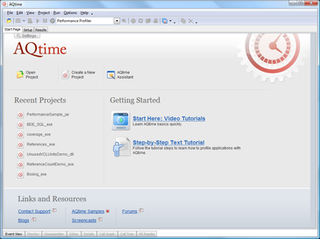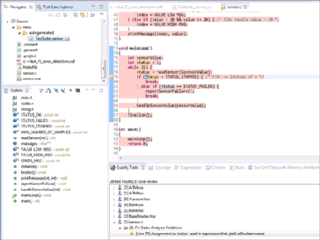An integrated development environment (IDE) is a software application that provides comprehensive facilities to computer programmers for software development. An IDE normally consists of at least a source code editor, build automation tools and a debugger. Some IDEs, such as NetBeans and Eclipse, contain the necessary compiler, interpreter, or both; others, such as SharpDevelop and Lazarus, do not.
In computer science, static program analysis is the analysis of computer programs performed without executing them, in contrast with dynamic program analysis, which is performed on programs during their execution.
Software testing is the act of examining the artifacts and the behavior of the software under test by validation and verification. Software testing can also provide an objective, independent view of the software to allow the business to appreciate and understand the risks of software implementation. Test techniques include, but not necessarily limited to:

Wolfram Mathematica is a software system with built-in libraries for several areas of technical computing that allow machine learning, statistics, symbolic computation, data manipulation, network analysis, time series analysis, optimization, plotting functions and various types of data, implementation of algorithms, creation of user interfaces, and interfacing with programs written in other programming languages. It was conceived by Stephen Wolfram, and is developed by Wolfram Research of Champaign, Illinois. The Wolfram Language is the programming language used in Mathematica. Mathematica 1.0 was released on June 23, 1988 in Champaign, Illinois and Santa Clara, California. Wolfram Research celebrated a third of a century of Mathematica on October 30th, 2021.
A programming tool or software development tool is a computer program that software developers use to create, debug, maintain, or otherwise support other programs and applications. The term usually refers to relatively simple programs, that can be combined to accomplish a task, much as one might use multiple hands to fix a physical object. The most basic tools are a source code editor and a compiler or interpreter, which are used ubiquitously and continuously. Other tools are used more or less depending on the language, development methodology, and individual engineer, often used for a discrete task, like a debugger or profiler. Tools may be discrete programs, executed separately – often from the command line – or may be parts of a single large program, called an integrated development environment (IDE). In many cases, particularly for simpler use, simple ad hoc techniques are used instead of a tool, such as print debugging instead of using a debugger, manual timing instead of a profiler, or tracking bugs in a text file or spreadsheet instead of a bug tracking system.

Computer-aided software engineering (CASE) is the domain of software tools used to design and implement applications. CASE tools are similar to and were partly inspired by Computer-Aided Design (CAD) tools used for designing hardware products. CASE tools were used for developing high-quality, defect-free, and maintainable software. CASE software is often associated with methods for the development of information systems together with automated tools that can be used in the software development process.
In software engineering, continuous integration (CI) is the practice of merging all developers' working copies to a shared mainline several times a day. Grady Booch first proposed the term CI in his 1991 method, although he did not advocate integrating several times a day. Extreme programming (XP) adopted the concept of CI and did advocate integrating more than once per day – perhaps as many as tens of times per day.

.NET Reflector is a class browser, decompiler and static analyzer for software created with .NET Framework, originally written by Lutz Roeder. MSDN Magazine named it as one of the Ten Must-Have utilities for developers, and Scott Hanselman listed it as part of his "Big Ten Life and Work-Changing Utilities".
Google Developers is Google's site for software development tools and platforms, application programming interfaces (APIs), and technical resources. The site contains documentation on using Google developer tools and APIs—including discussion groups and blogs for developers using Google's developer products.

EiffelStudio is a development environment for the Eiffel programming language developed and distributed by Eiffel Software.
A software repository, or repo for short, is a storage location for software packages. Often a table of contents is also stored, along with metadata. A software repository is typically managed by source control or repository managers. Package managers allow automatically installing and updating repositories.
The Wing Python IDE family of integrated development environments (IDEs) from Wingware was created specifically for the Python programming language, with support for editing, testing, debugging, inspecting/browsing, and error checking Python code.

AQtime is a performance profiler and memory/resource debugging toolset developed by SmartBear Software. It is integrated into Microsoft Visual Studio, Visual Studio Test Projects and Embarcadero RAD Studio that allows analyzing the application without leaving the development environment.
Software archaeology or source code archeology is the study of poorly documented or undocumented legacy software implementations, as part of software maintenance. Software archaeology, named by analogy with archaeology, includes the reverse engineering of software modules, and the application of a variety of tools and processes for extracting and understanding program structure and recovering design information. Software archaeology may reveal dysfunctional team processes which have produced poorly designed or even unused software modules, and in some cases deliberately obfuscatory code may be found. The term has been in use for decades, and reflects a fairly natural metaphor: a programmer reading legacy code may feel that he or she is in the same situation as an archaeologist exploring the rubble of an ancient civilization.
.NET Compiler Platform, also known by its codename Roslyn, is a set of open-source compilers and code analysis APIs for C# and Visual Basic (VB.NET) languages from Microsoft.

Parasoft C/C++test is an integrated set of tools for testing C and C++ source code that software developers use to analyze, test, find defects, and measure the quality and security of their applications. It supports software development practices that are part of development testing, including static code analysis, dynamic code analysis, unit test case generation and execution, code coverage analysis, regression testing, runtime error detection, requirements traceability, and code review. It's a commercial tool that supports operation on Linux, Windows, and Solaris platforms as well as support for on-target embedded testing and cross compilers.
Within software engineering, the mining software repositories (MSR) field analyzes the rich data available in software repositories, such as version control repositories, mailing list archives, bug tracking systems, issue tracking systems, etc. to uncover interesting and actionable information about software systems, projects and software engineering.
Software diagnosis refers to concepts, techniques, and tools that allow for obtaining findings, conclusions, and evaluations about software systems and their implementation, composition, behaviour, and evolution. It serves as means to monitor, steer, observe and optimize software development, software maintenance, and software re-engineering in the sense of a business intelligence approach specific to software systems. It is generally based on the automatic extraction, analysis, and visualization of corresponding information sources of the software system. It can also be manually done and not automatic.
Software Intelligence is insight into the structural condition of software assets produced by software designed to analyze database structure, software framework and source code to better understand and control complex software systems in Information Technology environments. Similarly to Business Intelligence (BI), Software Intelligence is produced by a set of software tools and techniques for the mining of data and software inner-structure. End results are information used by business and software stakeholders to make informed decisions, measure the efficiency of software development organizations, communicate about software health, prevent software catastrophes.





